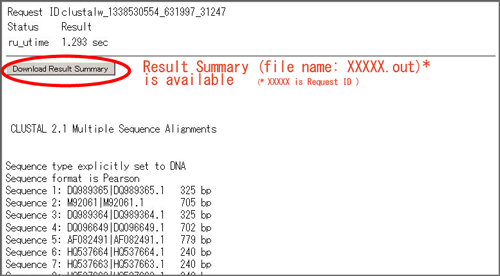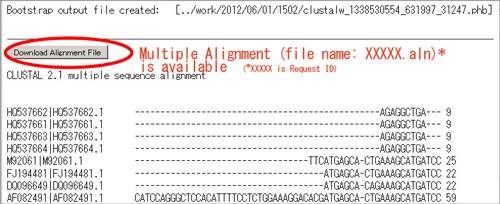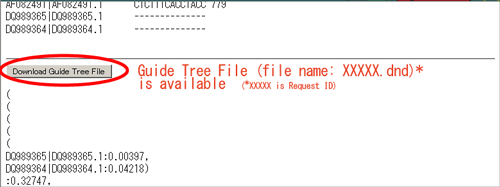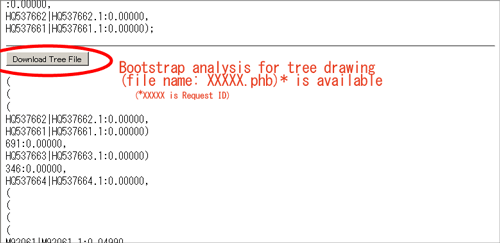ClustalW
ClustalW is a general purpose multiple sequence alignment program for
DNA or proteins.
DDBJ provides both the latest version and the DDBJ original version
(Version 1.83, Modified by Dr. Kirill Kryukov).
Version
Select “2.1” (Latest version) or “1.83” (DDBJ original, modified by Dr.
Kirill Kryukov). Default is Latest version.
In the “1.83”, you can specify the detailed option parameters for Tree calculation and Boostrap.
Sequences
Sequence Type
Select Protein or DNA to align. Default value is Protein.
Sequence Input
Enter or paste a set of sequences, or upload a file in any format (NBRF-PIR,EMBL-SWISSPROT, Pearson (Fasta), Clustal (*.aln), GCG-MSF (Pileup), GCG9-RSF, and GDE).
- Available sequence formats
- NBRF-PIR
- EMBL-SWISSPROT
- Pearson (Fasta)
- Clustal (*.aln)
- GCG-MSF (Pileup)
- GCG9-RSF
- GDE
Example (FASTA-Pearson format) :
>my_query_sequence_1
CACCCTCTCTTCACTGGAAAGGACACCATGAGCACGGAAAGCATGATCCAGGACGTGGAA
GCTGGCCGAGGAGGCGCTCCCCAGGAAGACAGCAGGGCCCCAGGGCTCCAGGCGGTGCTG
GTTCCTCAGCCTCTTCTCCTTCCTGCTCGTGGCAGGCGCCGCCAC
>my_query_sequence_2
GGCCAGGGCACCCAGTCTGAGAACAGCTGCACCCGCTTCCCAGGCAACCTGCCTCACATG
CTTCGAGACCTCCGAGATGCCTTCAGCAGAGTGAAGACTTTCTTTCAAATGAAGGATCAG
CTGGACAACATATTGTTAAAGGAGTCCTTGCTGGAGGACTTTAAG
>my_query_sequence_3
ATGGGTCTCACCTCCCAACTGCTTCCCCCTCTGTTCTTCCTGCTAGCATGTGCCGGCAAC
TTTGCCCACGGACACAACTGCCATATCGCCTTACGGGAGATCATCGAAACTCTGAACAGC
CTCACAGAGCAGAAGACTCTGTGCACCAAGTTGACCATAACGGAC
Each sequence needs the unique identifier, which starts from the
character following after “>” and ends at the first space. If you
do not use any space and/or tab, whole line is defined as the
identifier.
The duplicate identifier causes the error.
Pairwise Alignment Options
Alignment Type
The alignment method used to perform the pairwise alignments used to generate the guide tree. Default value is slow.
| Type | |
|---|---|
| slow | fine for short sequences but will be very SLOW for many long sequences |
| fast | FAST, but approximate |
Slow/Fast Pairwise Alignment Options {#Slow/Fast_Pairwise_Alignment_Options}
- DNA /Protein Weight Matrix
- Slow pairwise alignment DNA/Protein sequence comparison matrix series used to score alignment.
-
Protein Weight Matrix Gonnet These matrices were derived using almost the same procedure as the Dayhoff one (above) but are much more up to date and are based on a far larger data set. They appear to be more sensitive than the Dayhoff series. BLOSUM These matrices appear to be the best available for carrying out data base similarity (homology searches). PAM These have been extremely widely used since the late ’70s. They are also called Dayhoff’s matrix. ID This matrix gives a score of 1.0 to two identical amino acids and a score of zero otherwise. -
DNA Weight Matrix (Default value is IUB) IUB This is the default scoring matrix used by BESTFIT for the comparison of nucleic acid sequences. X’s and N’s are treated as matches to any IUB ambiguity symbol. All matches score 1.9; all mismatches for IUB symbols score 0. ClustalW Matches score 1.0 and mismatches score 0. All matches for IUB symbols also score 0. - GAP OPEN
- Gap opening penalty for Slow Pairwise Alignment. Default value is 10.0.
- GAP EXTENSION
- Gap extension penalty for Slow Pairwise Alignment. Default value is 0.1.
- KTUP (WORD SIZE)
- Size of exactly matching fragment that is used. Increase for speed, decrease for sensitivity. Default value is 1.
- WINDOW LENGTH
- Number of diagonals around each of the ‘best’ diagonals that will be used. Decrease for speed; increase for sensitivity. Default value is 5.
- SCORE TYPE
- Score type to output. Default value is percent.
- TOPDIAG
- Number of k-tuple matches on each diagonal. Decrease for speed; increase for sensitivity. Default value is 5.
- PAIRGAP
- Fast pairwise alignment gap penalty for each gap created. Default value is 3.
Multiple Sequence Alignment Options
Alignment Options
- DNA /Protein Weight Matrix
- 塩基置換行列表/アミノ酸置換行列表を指定します。デフォルトは Protein の場合は Gonnet , DNA の場合は IUB です。
-
Protein Weight Matrix Gonnet These matrices were derived using almost the same procedure as the Dayhoff one (above) but are much more up to date and are based on a far larger data set. They appear to be more sensitive than the Dayhoff series. BLOSUM These matrices appear to be the best available for carrying out data base similarity (homology searches). PAM These have been extremely widely used since the late ’70s. They are also called Dayhoff’s matrix. ID This matrix gives a score of 1.0 to two identical amino acids and a score of zero otherwise. -
DNA Weight Matrix IUB This is the default scoring matrix used by BESTFIT for the comparison of nucleic acid sequences. X’s and N’s are treated as matches to any IUB ambiguity symbol. All matches score 1.9; all mismatches for IUB symbols score 0. ClustalW Matches score 1.0 and mismatches score 0. All matches for IUB symbols also score 0. - GAP OPEN
- Multiple alignment gap opening penalty. Default value is 10.0.
- GAP EXTENSION
- Multiple alignment gap extension penalty. Default value is 0.2.
- GAP DISTANCES
- Multiple alignment gaps that are closer together than this distance are penalised. Default value is 5.
- NO END GAPS
- Multiple alignment disable the gap seperation penalty when scoring gaps the ends of the alignment. Default value is no.
-
Type Description no false yes true - ITERATION
- This can be used to improve the final alignment or improve the alignment at each stage of the progressive alignment. Default value is none.
-
Type Description none No iteration tree Iteration at each step of alignment process alignment Iteration only on final alignment - NUMITER
- Maximum number of iterations to perform. Default value is 1.
- CLUSTERING
- Clustering type. Default value is NJ.
-
Type Description NJ Neighbour-joining (Saitou and Nei 1987) method UPGMA Unweighted Pair-Group Method with Arithmatic mean method
Output Options
- Format
- Format for generated multiple sequence alignment. Default value is Aln w/numbers.
| Type | Description |
|---|---|
| Aln w/numbers | Residue numbers may be added to the end of the alignment lines in clustalw format. |
| Aln wo/numbers | Residue numbers may not be added in clustalw format. |
| GCG MSF | GCG MSF format |
| PHYLIP | PHYLIP interleaved alignment format |
| NEXUS | NEXUS format |
| NBRF/PIR | NBRF/PIR format |
| GDE | GDE format |
| Pearson/FASTA | Pearson / FASTA format |
- Order
- Control the order of the sequences in the output alignments. Default value is aligned.
-
Type Description aligned Corresponds to the order in which the sequences were aligned (from the guide tree-dendrogram). input Same order as the input sequences.
DDBJ Original version (Version 1.83, Modified by Dr. Kirill Kryukov) options
Tree calculation/BOOTSTRAP options
- Distance
- Specify the correction format. Default value is Kimura. Only Kimura and p-distance can be specified for PROTEIN. The options marked * are DDBJ’s original option formats.
- Method of phylogenetic tree
-
Method Model Note Kimura T C A G T - α β β C α - β β A β β - α G β β α - Distance estimated by assuming that the rates of transition and transversion are different p-distance Proportion of difference Jukes-Cantor* T C A G T - α α α C α - α α A α α - α G α α α - Distance estimated by assuming that all types of substitutions occur at the same rate Tamura* T C A G T - κπGC 1-πGC πGC C κ(1-πGC) - 1-πGC πGC A 1-πGC πGC - κπGC G 1-πGC πGC κ(1-πGC) - Distance estimated by assuming that the rates of transition and transversion are different, and taking into account the equilibrium frequencies of GC Tajima-Nei* T C A G T - απC απA απG C απT - απA απG A απT απC - απG G απT απC απA - Distance estimated by taking into account the equilibrium frequencies of T, C, A, and G Gojobori-Ishii-Nei* T C A G T - β γ β C α - α δ A ε β - β G α ζ α - Distance estimated by assuming that the rates are different not only for substitutions between GC and TA, but also for others Tamura-Nei* T C A G T - α2πC βπA βπG C α2πT - βπA βπG A βπT βπC - α1πG G βπT βπC α1πA - Distance estimated by assuming not only that the rates of transition and transversion are different but also the rates between TC and AG are different, and taking into account the equilibrium frequencies of T, C, A, and G - α, α1, α2 ,β, γ, δ, ε, ζ, κ : 塩基置換速度
- πT, πC, πA, πG, πGC : 平衡塩基頻度
- TOSSGAPS
- Specify ignore positions with gaps. Default is ON.
- OUTPUTTREE
- Specify the output format (options are phylip, nj and plylip distance). Default is phylip.
- COUNT
- Specify number of bootstraps. Default:1000 Range:1-10000
- SEED
- Specify seed number for bootstrap. Defalut:111 Range:1-1000
- Method of phylogenetic tree
- Methods for constructing the phylogenetic tree using the nucleotide or amino acid sequences may largely be classified into the distance-matrix methods and the character-state methods. In the distance-matrix method, the distance matrix, which consists of evolutionary distances (number of nucleotide or amino acid substitutions) between all possible pairs of sequences analyzed, is generated, and the phylogenetic tree fittest to the matrix is chosen. On the other hand, in the character-state method, the sequences are compared directly, and the phylogenetic tree fittest to the assumed pattern of nucleotide or amino acid substitution is chosen.
- In CLUSTALW, the phylogenetic tree is constructed by using the neighbor-joining (NJ) method, which belongs to the distance-matrix method. When the nucleotide sequences are analyzed, the p distance method, Kimura method, Tamura method, Tajima-Nei method, Gojobori-Ishii-Nei method, Tamura-Nei method, and so on, are available for estimating the number of nucleotide substitutions between sequences. These methods are different in the pattern (model) of nucleotide substitution assumed for estimating the evolutionary distance.
- Generally, the bases T (U) and C have a pyrimidine, and A and G have a purine in their chemical structure, and the physicochemical properties are similar within each group. In fact, the rates of nucleotide substitution between T and C and between A and G (transitions) are empirically known to be greater than those of the other types of substitutions (transversions). In addition, since the equilibrium frequencies of T, C, A, and G are usually different in a genome, the rate of nucleotide substitution appears to be dependent on the frequency of the base to which the original base is substituting. Another mechanisms are also considered to make the rate of each nucleotide substitution (T -> C, A -> G, etc.) different.
- These arguments suggest that assuming complex patterns of nucleotide substitution allows for accurate estimation of the numbers of nucleotide substitutions. However, the more complex models contain a greater number of parameters to be estimated, and the variances (standard errors) of the estimates become larger as the number of parameters increases. Since the parameter values are estimated from the sequence data analyzed, the accuracy of the estimates depends on the number of sequences, sequence length, and sequence divergence, etc. Therefore, the pattern of nucleotide substitution suitable for the analysis of sequences depends on the sequence data analyzed, and some methods are available for finding the fittest model for given sequence data.
- In CLUSTALW, the default method used for estimating the number of nucleotide substitutions is the Kimura method, because this method is one of the most widely used methods. However, if the fittest model to the sequence data analyzed is different from the Kimura model, it is possible that incorrect results are obtained. In such cases, it may be useful to try another models in the analysis.
- Similarly, the p distance method and Kimura method are available for estimating the number of amino acid substitutions between sequences in CLUSTALW. (Here the Kimura method for estimating the number of amino acid substitutions is totally different from the Kimura method for estimating the number of nucleotide substitutions.) The default method is the Kimura method, but the p distance method may also be useful for some data.
How to see the result screen
ClustalW analysis result
-
Result

-
Multiple Alignment

-
Guide Tree

-
Bootstrap analysis

(Note) Since April 2012, in the ClustalW ver.2.1, BOOTSTRAP is calculated automatically and “.phb” download file is placed, except for the following combination of [FORMAT] and [Clustering] options.
[FORAMT] [CLUSTERING] PHYLIP NJ NEXUS NJ PHYLIP UPGMA NEXUS UPGMA -
Phylogenetic Tree Construction
Please use phylogenetic tree visualization program (e.g. TreeView X, MEGA etc.) to construct a phylogenetic tree by using the output file.
How to view the results after closing the window
Using the Request ID, ClustalW analysis result is available by the
following URL.
Request ID is shown in the screen after submitting the query.
Please note that whoever knows Request ID can view the result.
//clustalw.ddbj.nig.ac.jp/cgi-bin/clustalwr.cgi?id=Request ID&output=aln1
About ClustalW
-
This program is : ClustalW2.1
-
References
- Larkin MA, Blackshields G, Brown NP, Chenna R, McGettigan PA, McWilliam H, Valentin F, Wallace IM, Wilm A, Lopez R, Thompson JD, Gibson TJ, Higgins DG. (2007). Clustal W and Clustal X version 2.0. Bioinformatics, 23, 2947-2948.
- Chenna R, Sugawara H, Koike T, Lopez R, Gibson TJ, Higgins DG, Thompson JD. (2003) Multiple sequence alignment with the Clustal series of programs. Nucleic Acids Res. 31(13):3497-500.
- Thompson JD, Higgins DG, Gibson TJ. (1994) CLUSTAL W: improving the sensitivity of progressive multiple sequence alignment through sequence weighting, position-specific gap penalties and weight matrix choice. Nucleic Acids Res. 22(22):4673-80.